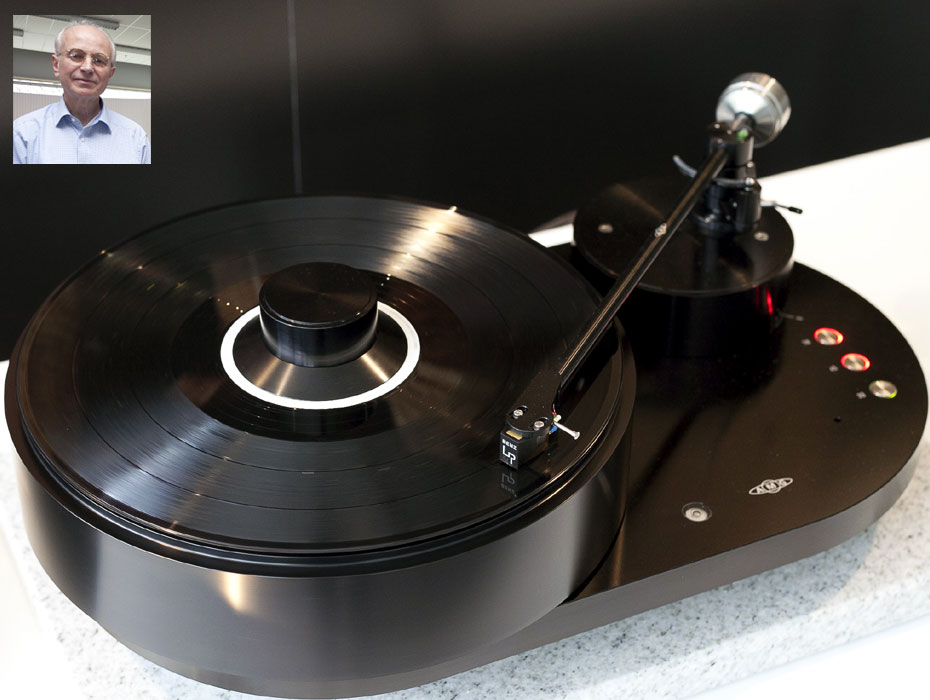by: Jason Kennedy
AMG Viella 12
This substantial turntable comes from a man who produces OEM parts for other German companies, a man called Werner Roeschlau who clearly knows his engineering onions. The Viella 12 is a superbly finished high mass design that incorporates a number of refinements to the norm. The main bearing for instance consists of a hardened steel shaft running in an aluminium rather than bronze housing, Roeschlau’s thinking being that the hydrodynamic nature of the lubricating oil means that it forms a skin between the two parts so there is no need for a special bushing, he cites the same approach found in modern car engines. The platter is solid aluminium with a machined PVC top surface, the centre spindle for the record is a separate element to both platter and bearing.
AMG also makes the 12-inch tonearm, a beauty with zero play tangential bearings and springs for vertical movement where you don’t want a great deal of movement with a clamped slab of vinyl. Power is from a sine wave motor that like the rest of the turntable is made in-house and designed specifically for the slow speeds required. At 48lbs the V12 is not as heavy as it looks and the sound is as nimble as you could desire.
(Pictured: W Roeschlau & AMG Viella 12)
Burmester 111
In the Burmester naming scheme the first number indicates the month and the last two the year in which the product was planned to launch. As we can tell from this it has taken more than another year for the company to finalise its most ambitious piece of electronics to date. The 111 is a combined music server and preamp that incorporates a drive for ripping discs and a minimum of two 1TB hard drives in a RAID configuration. The analogue preamp stage is galvanically isolated from the digital circuitry and has three analogue and six digital inputs. It has a 7-inch display, ‘high end’ ripping capability and the ability to source album art online alongside either 24/96 or 24/192 conversion options. It even has a UPS (uninterruptible power supply) in order protect the stored music in the event of a power outage. It’s one of those products where the company has attempted to think of every possible requirement and build in future proofing and to be frank it’s hard to see what they’ve missed.
Chord Electronics DSX1000
British electronics specialist Chord brought a slew of black anodised components to Munich, among these was a brand new network music player called DSX1000 shown mid stack in the picture. This is a high performance streamer that supports all the key formats including Apple Lossless and has a full colour display. It has the analogue volume control circuit from Chord’s Reference preamps and both line and variable level outputs. Networking is via Ethernet rather than wi-fi for quality reasons and the company recommends the home plug system where routers are not conveniently placed. The proprietary DAC reclocks incoming data in order to kill jitter and comprises technology from Chord’s QBD76HD standalone converter. Control is via front panel, IR or either Apple or Android touchscreen devices.
At the affordable end of its range Chord introduced the first DAC in its cute Chordette range, despite its meagre size the QuteHD “outperforms anything at whatever price” according to company MD John Franks. Apparently he is upgrading the more expensive DAC in the range to maintain its credibility. Capable of accepting both PCM and DSD over USB this is a 32-bit, 384kHz converter designed by Rob Watts that has a lot to prove.
(Left: John Franks & Chordette stack. Right: Chord Chordette DAC.)
(Chord Red Ref & DSX1000)
Göbel Epoque Fine
Göbel’s aluminium enclosures are not merely elegant pieces of audio sculpture, they feature a distinctive take on the flat panel drive unit. They call it a bending wave transducer which int eh case of the new Epoque Fine floorstander also includes an impulse compensating passive radiator, which I take to be the device on the back of the panel. This carbon fibre driver has a bandwidth of 150Hz to 30kHz and 180 degree dispersion. What the pictures don’t reveal is that it’s is a full dipole with not only front and rear output from the panel but three 7inch bass drivers on both sides. The Epoque Fine is a 220lb speaker but Göbel was demonstrating the Epoque Reference which has the another six driver bass section above the panel and almost doubles that weight. Yet it’s a system which sounded remarkably open, natural and even dynamic with a string quartet piece.
(Gobel Epoque Reference)
(Gobel Epoque Fine)
Voxativ PA-01
German loudspeaker company Voxativ made its name with a modernised and highly refined version of the classic Lowther full range driver. It makes two highly distinctive and extremely transparent loudspeakers which might be why it felt the urge to make the move into electronics. Its first creation is the PA-01 preamplifier, an all tube device with maximum control knob diameter all dual mono construction. It has a separate power supply and an onboard phono stage, in standard form you will find JJ-Electronic tubes but Voxativ also supplies NOS glass as an option. The volume control is stepped and motorised for remote control and it uses Mundorf caps in all the right places and pure copper connectors. In combination with partnering 845 mono power amps and the big flat Ampeggio Due speakers it was making some of the most real sounds of the show. The fact that the Revox tape player was spinning Joss Stone and Jeff Beck’s rendition of “People Get Ready” certainly helped.
(Voxativ system)
(Voxativ PA-01)
- (Page 1 of 1)

